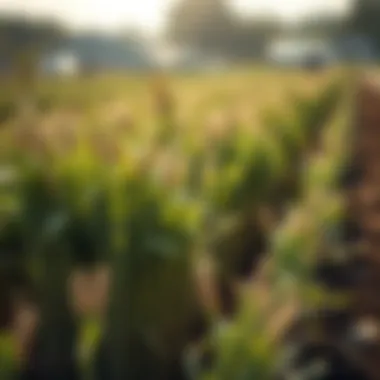Grants for Federal Agencies: Navigating Opportunities


Intro
In the intricate world of agriculture, securing grants from federal agencies is more than just a financial boon; it’s a gateway to innovative breakthroughs and sustainable practices. Many agencies offer financial support aimed at enhancing agricultural research, promoting environmentally-conscious methods, and pushing the boundaries of what we know in the fields of agriculture, horticulture, and agronomy. With the ever-evolving landscape of agricultural needs underscored by climate changes and technological advancements, understanding how to navigate the grants available is crucial for farmers and enthusiasts alike. This guide aims to dissect key trends, sustainable practices, and pivotal gardening techniques that underline the importance of grants within this sector.
Latest Trends in Agriculture
Overview of Current Trends
Agriculture is undergoing a transformation, manifested through several key trends. From precision farming to organic growing methods, the roles of grants in facilitating these trends cannot be overstated. For instance, the shift towards climate-resilient crops is gaining traction. Farmers seek funding to experiment with drought-resistant varieties, which suits their local environments better than conventional crops. Such innovations are vital in keeping pace with changes in weather patterns.
Impact of Technology on Farming Practices
Technology, too, plays a pivotal role in modern agriculture. The infusion of advanced tools like drones for crop monitoring or AI-driven data analysis systems aids farmers in making operational decisions based on real-time information. Grants are often essential to access these technologies, equipping farmers with the tools they need to sustain and enhance productivity.
"Investing in technology is investing in the future—federal grants serve as a financial bridge for many farmers looking to innovate."
Sustainable Practices: Towards a Greener Future
Importance of Sustainability in Agriculture
With the growing concern for the environment, sustainable practices are no longer just a trend; they are imperative. Implementing methods that minimize chemical use leads not only to improved public health outcomes but also restores ecosystems affected by intensive farming. Grants support research in this area, leading to breakthroughs in practices that reduce plant diseases and enhance soil health.
Methods for Sustainable Farming
Some established methods include:
- Crop rotation, which helps maintain soil fertility.
- Cover cropping to protect the soil in off-seasons.
- Integrated pest management, which reduces the need for harmful pesticides.
These practices, often necessitating new techniques and research, significantly benefit from the funding provided by federal grants.
Gardening Techniques and Tips
Essential Gardening Tools and Equipment
For those delving into personal or community gardening, having the right tools is paramount. Grants can assist in acquiring essential equipment such as:
- Soil testers to analyze soil health
- Compost bins for sustainable waste management
- Irrigation systems that conserve water
Seasonal Gardening Practices
Understanding local climates is key to successful gardening. Seasonal practices include:
- Starting seedlings indoors before the last frost.
- Implementing winter covers for protecting plants during colder months.
- Planning for crop rotations to prevent soil depletion.
Federal grants can provide invaluable resources for gardeners and farmers to adopt these practices effectively, ensuring longevity and sustainability in their gardening endeavors.
Intro to Federal Grants
Grants assigned to federal agencies play a pivotal role in shaping agricultural research, enhancing innovative practices, and promoting sustainability across various sectors. For farmers and enthusiasts alike, understanding this terrain is imperative, as these grants are often lifelines that help in evolving agricultural methodologies, from cultivating better crops to implementing greener practices.
The significance of this introduction lies in framing not just the context, but the opportunities that these grants bring forth for individuals and organizations aiming to push the envelope in agricultural sector. More than just a monetary resource, federal grants are instruments for progress and innovation that can transform visions into reality. They enable agencies to tackle pressing issues and introduce advancements that have long-term benefits for communities and the environment.
Definition and Purpose
When we talk about federal grants, it’s crucial to start with a clear definition. A federal grant can be defined as a financial award given by a federal agency to support specific projects or initiatives that align with national interests and priorities. Unlike loans, grants do not require repayment, which makes them an attractive option for many agencies. Their purpose goes beyond mere funding; they're designed to spur development in key areas like agriculture and promote research that aligns with broader government goals.
The primary purposes include, but are not limited to:
- Supporting innovative research in fields like agronomy and horticulture.
- Funding projects aimed at enhancing community resilience and sustainability.
- Providing educational opportunities for training the next generation of agricultural professionals.
Grants are often tailored to address specific issues, ensuring that resources are channeled toward making tangible impacts where they are most needed.
Historical Context
Understanding the context in which these grants exist is key to grasping their current relevance. The notion of providing financial assistance for public good has roots that go deep, with historical instances dating back to early governmental support systems. Since the mid-20th century, federal grants have evolved significantly, especially post-World War II, in response to the need for greater agricultural efficiency and advancements.
During the 1960s and 70s, as the agricultural sector underwent major transformations, the concept of grants gained momentum. The government's response to agricultural crises and the demand for increased food production led to the establishment of various grant programs designed specifically to support research and initiatives in agriculture.
Prior to this, funding was usually scattered, resulting in a piecemeal approach to addressing agricultural challenges. The introduction of targeted grants enabled a more strategic response and has allowed agencies to focus their efforts where they can achieve the most measurable impact.
As we look at the present narrative of federal grants, it's vital to recognize how this historical backdrop shapes current funding opportunities and influences future trends. Understanding these trends is not just academic; it can provide valuable insights for potential applicants looking to navigate the often complex world of federal funding.
This historical evolution sheds light on the need for continual adaptation in grant funding mechanisms to meet evolving agricultural challenges.
In summary, federal grants are not solely about the money; they embody a commitment to progress and support that resonates through advanced techniques in agriculture, fostering an environment where innovations can take root and flourish.
Types of Grants Available
Navigating the diverse world of grants can seem like trying to find a needle in a haystack, especially for federal agencies. Understanding the different types of grants available is crucial. Each type serves distinct purposes and can significantly impact agricultural research, sustainability practices, and community development. Having a clear grasp of these options enables agencies to select the most suitable grants for their initiatives, ultimately leading to effective resource allocation and enhanced outcomes.
Research Grants
Research grants are pivotal in fostering innovation and advancing knowledge in fields like agriculture, horticulture, and agronomy. They provide funding for academic institutions and public entities to conduct specific projects. Such grants typically support experimental studies, field trials, and theoretical research, aimed at bridging knowledge gaps and developing innovative solutions to pressing challenges.
The significance of research grants can’t be overstated. They are often tailored to specific objectives, whether it’s improving crop yields, developing disease-resistant varieties, or exploring new sustainable practices. Researchers vying for these grants must demonstrate how their projects align with federal priorities and exhibit a potential for broad applicability and real-world impact.
"Research grants not only facilitate discoveries but also provide a necessary foundation for future agricultural practices."
In addition, grantors often seek collaboration. Engaging multiple stakeholders can enhance the project's credibility and broaden its reach. Whether it's universities teaming up with private firms or local cooperatives partnering with government bodies, such collaborations often result in richer findings and more sustainable solutions.
Project Grants
Project grants represent a substantial category, often allocated for specific, finite projects aimed at achieving concrete results. Unlike research grants, which might explore broad concepts, project grants are focused wins—intended to implement initiatives that address specific community needs or trial new methods effectively.
An excellent example of a project grant could be funding for a local farmer cooperative to establish a community-supported agriculture program. This project might involve establishing partnerships with local businesses, social enterprises, and educational institutions to create a sustainable model of production and distribution.


This type of funding usually comes with stringent requirements regarding timelines, objectives, and deliverables. Therefore, clear planning and ongoing evaluation play crucial roles if agencies wish to succeed in utilizing project grants.
Training and Education Grants
Education and training grants are essential for enhancing the skills and knowledge of individuals within the agricultural sector. These types of grants focus on providing resources for workshops, seminars, certification programs, and curriculum development aimed at improving agricultural practices.
For instance, a training grant may fund a series of workshops where local farmers learn the latest techniques in organic farming or pest management. Such initiatives help ensure that farmers are informed of the most sustainable practices, keeping them competitive and environmentally responsible.
In a landscape that's always evolving, these grants serve as a bridge between new knowledge and its practical application in the field. By directly influencing the educational fabric of agricultural professions, they help cultivate a more adept workforce, ready to tackle the challenges ahead.
In summary, the types of grants available have pragmatic implications for federal agencies looking to enhance agricultural research and practices. Understanding them is the first step in leveraging these vital resources for community advancement.
Funding Sources for Grants
Understanding the funding sources underpinning grants for federal agencies is crucial for several reasons. It lays the groundwork for how funds are allocated and ultimately spent, impacting the effectiveness of various programs related to agriculture, sustainability, and innovation.
Importance of Funding Sources
Federal grants don’t just appear out of thin air; they are supported by a variety of funding sources, each with its own set of rules and implications. Setting the stage for a successful grant application means knowing where the money comes from and how it can be tapped.
Federal Budget Allocations
Federal budget allocations are like the heartbeat of grant funding. Every fiscal year, the government sets aside a portion of funds specifically for grants, and these allocations are debated in Congress.
- Significance: Those allocations help to sustain essential programs. Funding from federal budgets supports agricultural research initiatives, conservation projects, and community development programs.
- Influence: The rise or fall of allocations for grants can significantly affect agriculture-focused projects. For instance, if a budget cuts certain environmental programs, it could mean less available funding for sustainable practices.
Key aspects to consider:
- Annual Budget Balloons: Understand the timelines as Congress discusses budgets in the spring and votes on them by summer.
- Earmarks vs. Discretionary Funds: Some funds are earmarked for specific projects, while others are discretionary and can be applied broadly.
"Navigating the intricacies of federal budgets is no walk in the park, but for those who wish to harness these funds for community growth, knowledge is power."
State and Local Government Contributions
The state and local governments often complement federal funds with their contributions. This layer adds a different texture to funding opportunities, turning a one-size-fits-all federal grant into a patchwork quilt of local funding strategies.
- Supplementary Funding: Many times, federal grants require matching funds. State and local governments can step up to the plate, ensuring projects meet these match requirements.
- Local Needs Assessment: State and local agencies can be more in tune with community needs, driving grants toward projects that genuinely matter on the ground level, which might not always resonate in broader federal agendas.
Considerations:
- Grant Application Alignment: When you write a proposal, align your initiative with local goals.
- Networking: Establish relationships with local agencies, as they often have pots of money available specifically for regional initiatives.
Private Sector Partnerships
The corporate world is also getting involved in funding agricultural research and sustainability efforts. Partnerships with private firms can unlock a treasure trove of funding opportunities that federal agencies may not tap into otherwise.
- Mutual Benefit: These partnerships can create win-win situations. For example, a company focused on agricultural technology may provide funds for research in exchange for rights to potential inventions.
- Innovation and Expertise: Private sector contributions frequently come with not just money but also expertise in implementation, allowing projects to leap from proposal to reality at a much quicker pace.
Factors to weigh:
- Shared Goals: Only partner with entities whose values align with your project.
- Agreement Terms: Clearly outline the expectations and benefits in partnership agreements to avoid confusion or conflicts later on.
In summary, understanding the various funding sources available for grants is crucial for anyone navigating the complexities of federal grant acquisition. Each source brings its unique advantages and limitations, and wisely harnessing them can lead to significant advancements in agricultural practices and innovations.
Application Process for Federal Grants
Navigating the application process for federal grants is akin to finding your way through a complex maze. The significance of understanding this process cannot be understated. It serves as the foundational step for federal agencies aiming to access much-needed resources to fund various agricultural initiatives. Successful grant applications can bolster research, expand programs, and implement innovative projects that drive positive change in the agricultural landscape.
When engaged in this grant journey, it is crucial to be aware of various aspects. From researching available opportunities to submitting well-crafted documents, every step demands attention. The ultimate goal is to position yourself as a compelling candidate that aligns well with the funders' objectives. This section will break down the key components of the application process in an organized manner, ensuring you know the path ahead.
Identifying Relevant Opportunities
Finding the right grant opportunities is the first hurdle in the journey. It's like digging through a mountain of hay to find that needle which could potentially transform your agricultural project. Start by leveraging resources such as Grants.gov – an essential portal for anyone looking to secure federal funding. By using targeted keywords related to your project's focus—be it sustainability, agronomy, or horticulture—you can filter results to find grants that match your interests.
Remember, the competition can be fierce. Keep an eye on deadlines and eligibility criteria. In many cases, aligning your project goals with the priorities outlined in the grant opportunity announcement can substantially increase your chances of success. Participating in workshops and webinars hosted by grant-making agencies can also provide useful insights, helping you identify the most relevant opportunities.
Preparing Application Documents
Once the right opportunities are identified, the next step involves preparing application documents. This aspect cannot be overlooked; a well-prepared application can make all the difference. Start by gathering required information, which often includes project narratives, budgets, and letters of support. Getting the format right is just as important as the content. Specific grants may have strict formatting guidelines, and not adhering to these can lead to an automatic disqualification.
An effective project narrative should clearly articulate the objectives, methodology, and expected outcomes. Paint a vivid picture of how your project aligns with the funder's goals, emphasizing innovation and relevance. Supportive documents, such as letters from community partners, can also bolster your case. Demonstrating widespread support for your project showcases its importance and may sway decision-makers in your favor.
Submission Procedures
Finally, the submission process is where everything culminates. This stage shouldn’t be rushed, as attention to detail is crucial. Double-check your application against the grant requirements. Each federal agency may have specific submission procedures, so understanding them thoroughly can prevent unnecessary setbacks. While some grants require electronic submission via portals like Grants.gov, others may necessitate mailing paper applications.
After submission, keep an eye on communication from the agency. They may request further information or clarification. Prompt responses to inquiries can demonstrate your commitment and competence—a small but significant metric that some reviewers consider.
In summary, the application process for federal grants is intricate but navigable. By meticulously identifying relevant opportunities, preparing robust application documents, and following precise submission procedures, agencies can set themselves up for quality funding that can help propel agricultural research and innovation forward. While challenges may arise along the way, perseverance and attention to detail can lead to successful outcomes.
Criteria for Grant Selection
The criteria for selecting grants play a pivotal role in the success of federal funding applications. Understanding these criteria helps organizations align their proposals with the needs and objectives of funding agencies. Furthermore, meeting these criteria often enhances the chances of securing the necessary funding for crucial projects, especially in the realm of agriculture. Without a grasp on what these criteria entail, agencies and applicants could be shooting in the dark.
Relevance to Objectives
When evaluation teams sift through numerous grant applications, they look for clear relevance to the agency's goals. For instance, if a proposal primarily targets sustainable farming practices while the agency aims to bolster food security, then it may be deemed a mismatch. The key here is to thoroughly research the priorities outlined in the specific grant opportunity. Tailoring your proposal to explicitly show how your project supports the broader objectives can drastically improve your standing.
- Understand the Goals: Read the grant announcement carefully.
- Highlight Alignment: Clearly outline how your project aligns with funded objectives.
- Demonstrate Impact: Use data or case studies to illustrate potential impact on the community or sector.
Incorporating these elements fosters a compelling narrative, ultimately catching the interest of reviewers. It’s about painting a picture that closely mirrors the vision of the funding body.
Innovation and Impact
Innovation does not only refer to cutting-edge technology; it can also encompass new methodologies or strategies in agriculture. Grant reviewers often seek proposals that demonstrate how the suggested projects can lead to transformative results within the agricultural sector.
To stand out, consider addressing the following aspects:
- Novelty: Is there a unique approach that differentiates your project?
- Scalability: Can the results be scaled to benefit more extensive agricultural practices?
- Sustainability: Will the innovation lead to long-term benefits for communities or ecosystems?


A well-articulated concept of impact can set your application apart. By placing a firm emphasis on how your innovations will create lasting changes, you underscore the value of your work.
Budget Justification
Crafting a solid budget proposal is as vital as developing the project itself. A budget should not just be a number; it must narrate the story of your project’s financial needs. Reviewers assess whether the requested funds are justified and whether they contribute toward achieving stated objectives. To ensure a clear budget justification:
- Break Down Expenses: Clearly itemize all costs—personnel, materials, travel, etc.
- Relate Costs to Outcomes: Each line item should tie back to project objectives.
- Consideration of Indirect Costs: Address overhead or indirect costs that might not be immediately apparent.
An articulate budget not only reassures funding bodies of the responsible management of their resources but also illustrates the seriousness and feasibility of the proposed project.
"In grant applications, clarity in budget can often be the bridge between a proposal being accepted or rejected."
Through attention to these criteria—evaluating relevance, emphasizing innovation, and presenting a justified budget—agricultural projects can significantly enhance their likelihood of securing federal grants. Boning up on these aspects promises to improve both the quality and the impact of proposals submitted for funding.
Post-Award Management of Grants
Effective management of federal grants after securing the funding is a crucial aspect that can significantly impact the success of projects focusing on sectors like agriculture and agronomy. Post-award management is where the rubber meets the road, transforming plans on paper into actionable programs that yield real-world benefits. From ensuring compliance with guidelines to accurately tracking expenditures, this phase determines whether organizations will achieve their objectives and justify the funding received.
Monitoring and Reporting Requirements
One of the cornerstones of post-award management is the monitoring and reporting requirements. Who's been at the helm of a project knows that it's not just about getting the money; it’s also about demonstrating how it was utilized. For federal grants, these requirements are often meticulously outlined in the award documents. Grantees are expected to provide regular updates regarding the progress of their projects. This typically involves:
- Submitting periodic reports that detail project activities, outcomes, and impact.
- Keeping meticulous records of all data collected, ensuring it aligns with proposed objectives.
- Addressing any issues or deviations from the project plan promptly.
"Proper monitoring is not just a formality; it's a learning tool. It provides insights that can shape future strategies."
Having a structured approach to monitoring can also enhance relationships with funding agencies. Agencies appreciate transparency, and timely reporting can lead to stronger partnerships for future funding opportunities.
Accounting for Expenditures
Tied closely to monitoring is the need for accurate accounting of expenditures. This isn’t just a bureaucratic necessity but a vital part of maintaining trust and accountability. Federal grants often come with strict guidelines on how funds may be used. Hence, a robust accounting system should be in place to:
- Categorize expenses clearly—whether they be for salaries, materials, or equipment—matching them against budget proposals.
- Provide documentation supporting each expenditure, such as invoices or receipts, to safeguard against audits.
- Continually assess spending against the budget to ensure that resources are allocated efficiently and effectively.
A meticulous approach to accounting not only protects the organization's reputation but also prepares it for potential audits which can arise during or after the grant's life cycle. Without proper accounting practices, organizations can face significant challenges, including potential clawbacks of funds or diminished chances for future grants.
Challenges in Securing Federal Grants
Obtaining federal grants is often perceived as sailing through a smooth sea, but for many, it can feel more like navigating a stormy ocean. The challenges in securing these federal funding opportunities can't be overstated. Understanding these obstacles is crucial for farmers looking to enhance their agricultural practices or initiate innovative projects.
One of the prominent hurdles is the intense competition for limited funds. With a multitude of federal agencies disbursing grants, the demand often far outweighs the available resources. Everyone wants a piece of the pie, and that makes the selection process appear daunting. Many farmers and organizations submit well-crafted proposals, but only a fraction gets funded. This creates a tight-knit environment where applicants must not only present compelling ideas but also articulate why their projects align closely with federal goals.
Another critical element to consider is resource allocation. Federal grants aren't just handed out for the asking; the decision-makers have to ensure that the funds go to projects that exhibit both potential impact and relevance. Oftentimes, resources are funneled towards initiatives that have the backing of large coalitions or those that can demonstrate immediate benefits to widespread issues. For an individual farmer or smaller organization, this might mean playing a game where the odds seem stacked against them.
"In the realm of grants, small fish may find it hard to swim with the big ones."
Competition and Resource Allocation
In terms of competition, many applicants find themselves in a tight spot. Large institutions, research organizations, and NGOs frequently dominate the landscape. They possess vast benchmarking data, experienced staff, and past success stories that can overshadow smaller entities. On the flip side, federal agencies aim to fund projects that provide the greatest return on taxpayer investment. This creates a vicious cycle that can be hard to break into.
If you're a small farmer or a community-focused organization, it becomes essential to network and collaborate with others. Partnerships can amplify proposals and showcase a more extensive support system, increasing the likelihood of winning funding. Forming alliances with universities or research institutions can bolster credibility and perhaps even bring extra expertise to the table, something that catch the attention of grant reviewers.
Regulatory Barriers
Next, we step into the tricky terrain of regulatory barriers. Navigating through federal regulations can feel like wading through a swamp—slow, and at times overwhelming. Each federal agency has its own set of rules and requirements that applicants must adhere to. This can range from strict documentation protocols to comprehensive reporting guidelines post-award.
It’s critical for applicants to familiarize themselves with the specific guidelines of the grant they are pursuing. Failing to follow these regulations can lead to disqualification or delays in getting funds when the application is successful. Even minor oversights can be what breaks or makes a funding request. For example, missing deadlines or not providing adequate budget justifications often leads to automatic rejections.
Farmers should invest the time in deep diving into the regulations and seek guidance when there's uncertainty. Plus, being diligent in following up with agencies can prevent miscommunication and keep the application on the right track.
To sum up, the road to obtaining federal grants is often filled with challenges. Competition is fierce, and regulatory barriers can make the process feel convoluted. However, understanding these hurdles can empower potential applicants to strategize and improve their chances of success in securing valuable funding.
Case Studies of Successful Grant Utilization
Exploring case studies of successful grant utilization can provide agricultural stakeholders with real-world examples of how federal grants can spur significant advancements in the sector. These case studies serve as valuable learning tools, revealing not just the outcomes, but also the thought processes and strategic approaches taken by successful grant applicants. In the field of agriculture, where challenges are plenty, understanding these success stories can inspire innovation and provide pathways to overcome obstacles that farmers and agricultural enthusiasts face.
Innovative Agricultural Research Projects
One notable case study is the collaboration between the USDA National Institute of Food and Agriculture (NIFA) and various research institutions to fund innovative projects aimed at combating climate change's effects on crop yields. For instance, a project funded by a competitive research grant focused on developing drought-resistant corn varieties. This project involved multiple stages, including extensive field trials and genetic research, contributing to a refined understanding of plant resilience.
The lessons learned from this initiative highlight several critical components:
- Collaboration: Bringing together agronomists, geneticists and local farmers fostered knowledge exchange and encouraged practical applications of the research findings.
- Funding Allocation: The method of funding was transparent, allowing for tailored resource allocation to critical stages of the research.
- Monitoring Impact: Regular assessments ensured that the project stayed aligned with its goals, a factor often overlooked in grant-funded projects. This subsequently translated into better crop management strategies for local farmers.
Such successful projects not only provide direct benefits—improved crop varieties—but also encourage a culture of research and development. They showcase how federal grants can mobilize resources effectively and create significant agricultural advancements.
Community-based Initiatives
In another illuminating study, a community-based initiative was developed through a grant aimed at enhancing food security in underserved areas. This initiative, known as "Urban Growers Collective," received funding from the USDA’s Community Food Projects Competitive Grants Program. The focus was on establishing urban gardens and organizing educational workshops surrounding sustainable agriculture practices for low-income neighborhoods.
The outcomes were particularly impressive:
- Over 200 community members actively participated in the workshops, leading to an increase in local food production.
- The project scored high on increasing awareness about nutrition, with participants reporting an uptick in the quality of diets due to greater access to fresh vegetables.
- Additionally, local partnerships with health organizations provided frameworks for continuous education about nutrition and responsible farming practices.
The takeaways from the Urban Growers Collective illustrate the profound impact that grant funding can have not just economically, but socially and nutritionally within communities. By fostering collaboration among community members and leveraging local partnerships, the project created a sustainable ecosystem that benefited all stakeholders involved.
Successful grant projects demonstrate that funding is not merely about resources; it's about empowering communities and advancing knowledge that leads to long-term change.
These case studies of successful grant utilization indicate that taking a well-rounded approach—considering the collaborative dynamics, innovative frameworks, and community involvement—can yield exemplary results. For agricultural farmers and enthusiasts, they underscore the immense potential federal grants hold in driving sustainable growth and ensuring food security.
Future Trends in Federal Grant Funding
The landscape of federal grant funding is continually evolving, shaped by the shifting priorities of federal agencies, emerging global challenges, and the progressive needs of the agricultural sector. Understanding the future trends in this area is vital for stakeholders engaged in agricultural research and innovation. Such trends not only signal the direction in which funding opportunities may flow but also highlight the critical areas that deserve attention and investment.
Shifts in Policy and Focus


As the federal government navigates new challenges, we observe significant regulatory and policy changes affecting grant funding. One of the primary areas of focus involves the realignment of incentives to align with national priorities. For example, in recent years, there has been a marked pivot toward addressing food security and climate change. Such shifts are reflective of a growing recognition that agricultural sustainability is intertwined with broader socio-economic issues.
In practical terms, this may manifest through increased funding allocations to projects that promote advanced agricultural techniques or technologies that reduce carbon footprints. Consequently, stakeholders—be they farmers, research institutions, or NGOs—must stay attuned to these policies, as they can heavily influence grant availability and the specific criteria employed in grant selection.
"Understanding governmental priorities can be akin to reading the winds; it informs how we should navigate the seas of grant opportunities."
Increased Emphasis on Sustainability
With the escalating urgency surrounding climate issues, sustainability is now a cornerstone in the stream of federal funding. Grants increasingly favor projects that demonstrate sustainable practices, be it through regenerative agriculture, precision farming, or reduced chemical inputs. This prioritization highlights a critical understanding within federal agencies: sustainable practices not only enhance environmental health but also improve economic viability for farmers in the long run.
For example, grant proposals featuring innovative irrigation systems that save water and energy or those that utilize bioengineering to produce drought-resistant crops may receive priority funding. Federal agencies like the USDA are ramping up investment in these areas, considering them essential for future food security.
As such, farmers and agricultural entrepreneurs are encouraged to pivot their focus toward sustainability in their funding applications. Crafting a proposal that illustrates the potential for innovative sustainable practices can significantly enhance the chance of securing funding. Paying attention to this emphasis on sustainability can be an important differentiator in competitive grant applications.
In summary, the convergence of policy shifts and a heightened focus on sustainability will shape the grant funding environment moving forward. Farmers and agricultural innovators thus have a unique opportunity to align their projects with these trends, ultimately enhancing both their chances of success and contributing to the larger mission of sustainable agriculture.
For further reading on trends influencing agricultural funding, you can consult resources at nationalaglawcenter.org or visit usda.gov.
The dynamic landscape of federal grant funding holds both challenges and opportunities, making it imperative for those involved in agriculture to stay informed and adaptable in their approaches.
The Role of Technology in Grant Management
Navigating the maze of federal grants is no small feat, and in today’s digital age, technology plays a pivotal role in streamlining this process. The integration of modern technology into grant management not only simplifies proposal submissions but also enhances monitoring processes, thus increasing the effectiveness and efficiency of fund utilization. This section underscores how technology can be a game changer for federal agencies, fostering a more closed loop of communication and improved results.
Digital Platforms for Proposal Submission
In the world of grant management, digital platforms have become the bread and butter for agencies and applicants alike. Gone are the days of pouring over paper stacks or sifting through endless emails. These platforms provide a centralized space for submitting proposals, tracking submissions, and communicating with reviewers. The user-friendliness of systems like Grants.gov or the National Institutes of Health’s eRA Commons allows applicants to prepare and submit proposals with greater ease. This not only saves time but also reduces the chances of administrative errors.
Here are several benefits of using these digital platforms:
- Increased Accessibility: Applicants can access the system from anywhere with an internet connection, making it easier for farmers and small businesses to engage in the funding process.
- Real-time Updates: Platforms often provide notifications and updates on the status of proposals, eliminating uncertainties about how applications are progressing.
- Resource Libraries: Many platforms host instructional materials and past successful proposals, offering insights that can bolster an applicant’s chances of success.
However, despite the numerous advantages, a few considerations remain:
- Digital Literacy: Not everyone may be comfortable navigating technology, which could limit access.
- System Downtime: Technical glitches or system outages can pose significant frustrations, particularly as deadlines loom.
Data Analytics in Monitoring Progress
Another technological emphasis in grant management is the utilization of data analytics, which empowers agencies to monitor funding effects and project outcomes efficiently. By leveraging data tools, agencies can extract and analyze trends from funded projects, allowing them to gauge success and areas needing adjustment.
Key benefits of employing data analytics include:
- Enhanced Decision Making: By evaluating data, agencies can make informed decisions on future funding allocations, ensuring that resources are directed toward projects demonstrating tangible impact.
- Accountability: Data analytics fosters a culture of transparency. When agencies can monitor exact expenditures and outcomes, it builds trust with funding sources.
- Longitudinal Studies: Aggregating data over time allows agencies to assess the sustained impact of grants, making it possible to highlight success stories and garner more funding.
Some challenges do exist. Notably, the quality of data relies heavily on the rigor of project managers in maintaining robust data records. If records are kept poorly, the insights drawn from analytics could be misleading.
"Technology is not a panacea, but when applied carefully, it can significantly transform grant management, improving both accessibility and accountability in the process."
In summary, technology shapes the future of grant management, making it not just manageable, but also more relevant, impactful, and user-friendly. As federal agencies continue to adapt to these advancements, they pave the way for a more collaborative and effective grant funding landscape.
Collaborative Funding Opportunities
Collaborative funding opportunities are crucial in the landscape of federal grants, especially for agencies looking to tackle significant challenges in agriculture and related fields. These collaborations serve more than just pooling financial resources; they bring together diverse perspectives, expertise, and networks. By uniting public and private sectors, organizations can enhance their capabilities and maximize impacts on sustainable agricultural practices.
Public-Private Partnerships
Public-private partnerships (PPPs) represent a hallmark of innovative funding strategies. These partnerships can take many forms, from cooperative research initiatives to shared resource projects. For instance, agricultural research institutions might partner with corporations to develop new seed varieties that are resistant to drought. Such alliances can streamline the process from research to market, reducing the time it takes for innovations to reach farmers.
The benefits of PPPs include:
- Shared Risks: Both parties can share the financial risks associated with agricultural projects, making them less daunting for each individual entity.
- Resource Optimization: By pooling resources, partners can achieve more than they could alone, leveraging each other's strengths for better outcomes.
- Enhanced Credibility: Working alongside recognized private entities can bolster the public perception of a project, attracting further investment and participation.
However, PPPs also come with considerations that must be navigated carefully. The alignment of goals is key; if public interests conflict with corporate motives, the partnership can falter. Clear and consistent communication is essential to ensure that both parties remain aligned throughout the project's lifecycle.
Multi-agency Collaborations
Multi-agency collaborations are another vital avenue for funding in federal grants. These partnerships can involve state, local, and federal agencies coming together to tackle complex agricultural challenges. Imagine a scenario where the Department of Agriculture teams up with the Environmental Protection Agency and local state governments to implement a comprehensive water conservation program. Such collaborative efforts often yield more effective solutions because they harness the strengths and resources of multiple stakeholders.
The advantages of multi-agency collaborations include:
- Holistic Approaches: By integrating the expertise of various agencies, projects can address environmental, economic, and social factors more thoroughly.
- Increased Funding Opportunities: A collaborative approach can unlock additional funding channels, as agencies can apply for grants targeting specific joint objectives.
- Knowledge Exchange: This arrangement fosters an environment of learning where agencies share best practices, methodologies, and data, leading to improved project implementation.
Nonetheless, challenges exist within multi-agency collaborations. Different agencies may have their own bureaucratic hurdles and timelines, which can complicate coordination. Establishing a common framework and mutual understanding from the get-go is essential to maximize the potential of such collaborations.
As both public-private partnerships and multi-agency collaborations thrive, they create richer ecosystems for advancing agricultural innovation. Future federal grants will likely depend on the ability of agencies to form robust and effective collaborations that resonate with current agricultural and environmental needs.
"Collaboration is about the journey, not just the outcome. It’s where ideas ignite and partnerships flourish."
End and Recommendations
In wrapping up our exploration of federal grants, it's clear these funding avenues hold considerable importance not only for federal agencies but for the broader agricultural sector. Grants help bridge the gap between innovative research and practical applications in fields such as agriculture, horticulture, and agronomy. They encourage the pursuit of sustainable farming and the development of environmentally sound practices, shaping the future of agriculture in ways that resonate with both local communities and global markets.
Summary of Insights
The article has traversed various aspects of federal grants, shedding light on their diverse types, the complexities involved in application processes, and the criteria that determine successful allocation of funds. Key insights include:
- Types of Grants: Understanding research, project, and educational grants enhances the ability of agencies to tap into the resources best aligned with their goals.
- Application Nuances: Each step from identifying opportunities to submitting a proposal is critical. A well-structured application can make or break funding chances.
- Post-award Management: Successful grant management doesn't end once funds are received. Ongoing compliance with reporting and monitoring is essential for ongoing success.
Guidelines for Successful Applications
To secure federal grants, meticulous preparation is necessary. Here are some vital steps that can bolster the likelihood of success:
- Tailor Your Proposal: Understand the funding agency's mission and align your objectives with theirs. Demonstrating how your project fits into their vision can strengthen your application.
- Focus on Impact: Clearly articulate how your project will create a measurable impact on the community or field. Use specific data and projected outcomes to substantiate your claims.
- Budget Rigor: Ensure your budget is realistic and adheres to the guidelines provided by the funding agency. A well-justified budget can demonstrate your commitment to responsible financial management.
Final Thoughts on Future Directions
Looking ahead, as the world faces pressing challenges such as climate change and food security, the role of federal grants will likely evolve. Key shifts to watch for include:
- Increased Focus on Sustainability: With growing awareness of environmental issues, future funding opportunities may increasingly prioritize projects that contribute to sustainability.
- Cross-disciplinary Collaboration: As agricultural challenges become more complex, collaboration across various disciplines - from technology to social sciences - will be critical. Federal grants may start supporting initiatives that bring diverse perspectives together.
- Leveraging Technology: The intersection between technology and agriculture is ripe for exploration. Future grants may aim to fund innovative tech solutions that enhance agricultural practices.
"The landscape of grants is continuously evolving, and the proactive agency will not only need to adapt but anticipate future needs and challenges."
By keeping these considerations in mind, agricultural agencies can better position themselves to navigate the intricate world of federal grants, ensuring they harness these opportunities effectively to foster growth and innovation.







